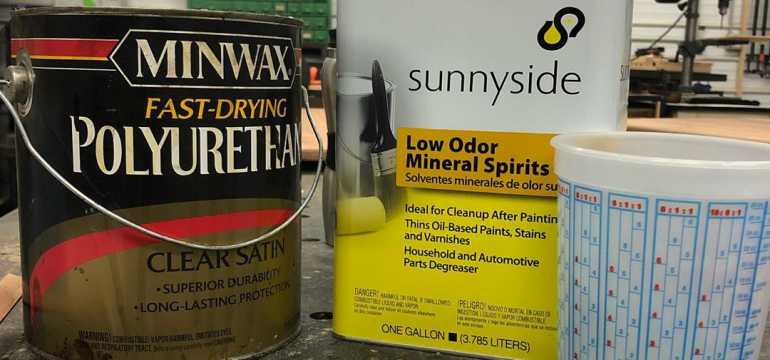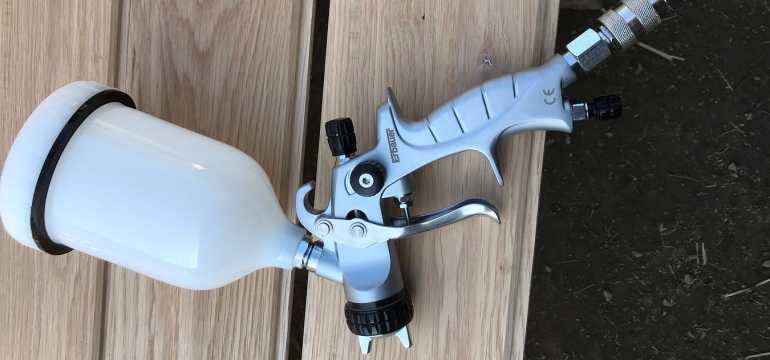It’s always important to have a nice clean finish on a project you have been working on. In some cases, you might find it helpful to thin out the type of finish you are using, such as polyurethane finish. The method of application can sometimes make it desirable to thin polyurethane or other types of finish. And you may find that certain levels of humidity or heat in your work area can also make it necessary to thin out the finish.
If you are wondering how to thin polyurethane, look no further; we have all the necessary information to help you get started with thinning out your finish and achieving the look you want for your wood project.
Finishes That Don’t Need Thinning
So let’s start out by reviewing which types of finish do not need to be thinned, under most circumstances. If you are using hardwax oils, you will probably not need to add any kind of thinner. The same goes for oil finishes such as linseed and tung oil finish. Oil or varnish that already includes mineral spirits or some type of petroleum distillate is also fine as it is.
These types of finishes are supposed to be applied using a rag or brushed on in a series of thin coats. Most finishes that have a water base are already thin enough. They are typically rendered thinner and liquid using either water or a commercial retardant that may contain ingredients such as propylene glycol.
Water-based finishes are popular in part because of their low VOC levels, which means that they are not as toxic as some other finishes, and they do not have as strong a smell. Because of its innate consistency, thinning water-based polyurethane is not usually necessary.
Common Finishes That Might Need to Be Thinned
The traditional finishes include lacquer, shellac, oil-based polyurethane, and oil-based varnish. Any of these common finishes may need to be thinned, depending on the conditions in your workshop and the final look that you want for your project.
How to Thin Polyurethane
 Now we are getting down to the practical steps you need to take to thin out polyurethane. Typically, when you are thinning out oil-based polyurethane or oil-based varnish, you will be working with mineral spirits. First of all, you need to think about ratios. The usual ratio is about 3 or 4 parts varnish to one part of the mineral spirits. However, you can go as far as half mineral spirits and half poly. This thinner mixture yields a wiping varnish that will yield a “hand-rubbed” look.
Now we are getting down to the practical steps you need to take to thin out polyurethane. Typically, when you are thinning out oil-based polyurethane or oil-based varnish, you will be working with mineral spirits. First of all, you need to think about ratios. The usual ratio is about 3 or 4 parts varnish to one part of the mineral spirits. However, you can go as far as half mineral spirits and half poly. This thinner mixture yields a wiping varnish that will yield a “hand-rubbed” look.
The thinner the varnish, the more numerous the coats will need to be. You should allow the coats to dry thoroughly in between, and depending on the type of poly or varnish, you may also need to sand just a bit. A wiping varnish requires ten, twelve, or more coats to give a good solid coat for your project.
However, a brush-on finish that has only been moderately thinned may require fewer coats. Check and see what the recommended number of coats is when the product is at its full strength, and then add two or three extra coats beyond that.
Why Thin Polyurethane?
Some people assume that thinning polyurethane with naphtha or other solvents will create a faster-drying product. However, this isn’t necessarily true. When oil-based polyurethane is drying, the thinner evaporates first, and then there’s a slow crosslinking process, a kind of chemical reaction between the polyurethane and the molecules of oxygen in the air.
Just because you add more thinner doesn’t mean that this second stage will go any faster. The process of the oxygen reaction will take the same amount of time. Sure, you will be applying thinner coats, and they may appear to dry faster, but you will also have to apply more coats. So you are not actually moving your project along any faster by thinning polyurethane.
Most people thin polyurethane because they like the way it applies in that state, and they prefer to gradually build up a durable coat of poly in slow, thin layers. Some may also prefer the look that it yields. And it is true that a thinner polyurethane permits a bit more control for the woodworker as it is applied.
Since you are laying on thin layers, you can see exactly when you need to stop, when the coat is thick enough to provide protection but not so thick that it makes the object you’re treating look too plastic.
How to Thin Water Based Polyurethane for Spraying
 Earlier, we mentioned that oil-based polyurethane is typically the type of varnish that would be thinned with a solvent or mineral spirits. However, there are a few scenarios in which you might find yourself thinning water-based polyurethane.
Earlier, we mentioned that oil-based polyurethane is typically the type of varnish that would be thinned with a solvent or mineral spirits. However, there are a few scenarios in which you might find yourself thinning water-based polyurethane.
Using Water-Based Poly as a Spray
First of all, if you have a large surface that you want to varnish, and you are using water-based poly as a protectant, you might want to speed up the process by spraying the water-based polyurethane rather than wiping or brushing it on.
In this case, you may need to thin out the poly a little bit, so it is easier to spray. You can use a ten percent additive of mineral spirits, but be sure that you are operating within the rules for safe usage for your local area. A few states forbid people from adding any kind of solvent to polyurethane purchased in a sealed can at a store. It’s a measure in effect due to safety concerns.
Adjusting Water-Based Poly to Temperature and Humidity Conditions
You may also need to use a solvent or extender if you are working in very dry or hot weather and temperature conditions. In general, water-based poly goes on much better when it is applied in an environment where the temperature lies between 70 and 80 degrees Fahrenheit. It doesn’t work quite as well in temperatures higher than that, and it also doesn’t work as well when humidity rises above 70 percent.
In hot, dry air, it is tough to keep your brush nice and wet enough to smoothly apply the poly. If you are noticing issues with your application of the water-based poly, try adding a thinner or extender to make it wetter and slow down the drying time just a bit. This strategy is also helpful if you are working on a very large project.
Restoring Older Polyurethane
If your water-based polyurethane is a little older and has a thin skin formed over its surface, you may need to treat it to make it usable again. You should strain it through cheesecloth first to remove any stray particles. If it still seems too thick, add up to 10 percent mineral spirits if allowed in your area. Test the substance on scrap wood. If it doesn’t work well, but a new can of poly.
Making Water-Based Poly Look Like Oil-Based Poly
If you prefer the qualities of water-based poly, but you want the look of oil-based, you can add some tint before applying the water-based version you plan to use. TransTint Honey Amber is one option that some woodworkers like to use.
You can either create a weak dye and apply it straight onto the wood or you can actually add the tint to the poly. Try your solution on some extra scraps of wood first, to make sure that is yielding the look you want to have for your project.
Protection from Thinners
 You may already know about the risks from breathing in the fumes from varnishes and thinners; however, it bears repeating that these products can not only cause temporary respiratory distress but can also have an adverse effect on your health over time.
You may already know about the risks from breathing in the fumes from varnishes and thinners; however, it bears repeating that these products can not only cause temporary respiratory distress but can also have an adverse effect on your health over time.
In other words, if you are frequently exposed to the toxic fumes from these substances without adequate protection, you are likely to experience longterm effects from them. In fact, some of these solvents can actually cause damage to the nervous system if you are exposed over and over, longterm, without correct protection. Here are some steps you can take to protect yourself when you are thinning polyurethane.
First of all, make sure that you are working in an open space, if at all possible, or at least in an area that is well ventilated. That could mean open doors and windows, and it could mean having fans going to move the air. Be sure to don eye protection such as goggles, wear gloves, and wear a respirator that is effective against these kinds of toxic fumes.
Keep in mind that the mineral spirits you will be using to thin polyurethane can cause skin irritation, so you should also wear long sleeves if possible and avoid spilling these substances on your skin.
Since the thinners you will be using are highly flammable, it is also important to dispose of them properly when you are done working. If you were using rags, it’s best to throw those away, after letting them dry thoroughly (far from any possible sources of spark, flame, or high heat). Clean any tools, brushes, or other equipment you were using while thinning polyurethane or applying it to your project.
Overview
All in all, the basics of thinning polyurethane are fairly simple. Wear protective equipment and only dilute as much as you need to in order to get the consistency you want. Take care with the disposal of soiled rags and leftover solvents.
Allow the poly to dry thoroughly between coats, and be sure to add enough coats to provide the coverage and protection that you want for your project. Be sure to purchase a high-quality type of polyurethane with good ratings and reviews.
- How to Cut Lexan - September 25, 2020
- Mineral Spirits vs. Mineral Oil - September 25, 2020
- Shellac vs. Polyurethane - September 24, 2020

K. Watkins
Friday 29th of December 2023
My acrylic-painted bottles are much more brilliant with a coat of polyurethane on them, plus it makes them usable and washable. But, after about 8 months, the polyurethane became thick and difficult to brush onto the bottles, and it left streaks-- heavy yellowed streaks where once it left the clear glass behind the paint just as clear and see-through as it was without this coating. Now it's ridged and foggy-looking. It looks terrible. I think I ruined one of my prettiest bottles and I want to know if there is hope of salvaging it. It's "oil-modified" and it's finish is "warm gloss." I clean my brush with only water and it works perfectly. Is there a thinner that I can brush on top of the thick coat that will dissolve it to make is clearer without disturbing the paint on the bottle? And if that is not salvageable, how can I treat the polyurethane to get a clear, smooth coating on future glass bottles painted with acrylic paint?
DaveH
Thursday 7th of July 2022
Thanks for the tips!!